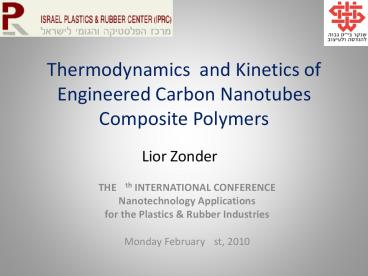Thermodynamics and Kinetics of Engineered Carbon Nanotubes Composite Polymers - PowerPoint PPT Presentation
1 / 26
Title:
Thermodynamics and Kinetics of Engineered Carbon Nanotubes Composite Polymers
Description:
Thermodynamics and Kinetics of Engineered Carbon Nanotubes Composite Polymers Lior Zonder THE 5th INTERNATIONAL CONFERENCE Nanotechnology Applications – PowerPoint PPT presentation
Number of Views:76
Avg rating:3.0/5.0
Title: Thermodynamics and Kinetics of Engineered Carbon Nanotubes Composite Polymers
1
Thermodynamics and Kinetics of Engineered Carbon
Nanotubes Composite Polymers
Lior Zonder
- THE 5th INTERNATIONAL CONFERENCE
- Nanotechnology Applications
- for the Plastics Rubber Industries
- Monday February 1st, 2010
2
Motivation
- Carbon nanotubes (CNT)
- Mechanical properties
- Electrical properties
- Enhancement of electrical properties of high
performance polymer compounds - Electrostatic dissipation
- Electrostatic painting
- EMI shielding
- Transparent electrical conductors
- Lightweight conductive materials
- PEM fuel cells
Marx, G.K.L., et al., Applied Physics Letters,
2003. 83(14) p. 2928.
3
Motivation
- Conductive plastics
- Not new concept
- Formation of 3D network throughout the bulk
10
1
- Carbon nanotubes
- Low percolation threshold
- Due to aspect ratio
- Carbon black
- High loadings
- Loss of mechanical properties
4
Motivation
- Further reduction in filler content achieved by
matrix morphology control - Specific location of filler in multi-phase system
- Percolation network forms in one phase or at the
interphase - Double percolation concept
10-7
10-12-10-10
Wu, D., et al.,. Biomacromolecules, 2009. 10(2)
p. 417-424.
5
Objective
- Understand the forces involved in determining CNT
location in a two phase polymer blend - Thermodynamic
- Kinetic
- Establishing the relationship between mixing
procedure, material morphology and properties - Develop a model relating kinetic and
thermodynamic factors to final morphology
6
Background
- Why CNT distribute unevenly in polymer blend?
- thermodynamics particles interact more favorably
with one of the polymers thus decreasing the
systems free energy - kinetics viscosity ratio as a distributing
factor - What are the circumstances that cause one factor
to dominate over the other?
7
Thermodynamics
- Expressed in terms of interfacial interactions
- Particle will tend to locate to minimize
interfacial tension - Quantified by the wetting parameter
particles are present only in polymer 1
Particles are present in polymer 2
particles are concentrated at the interface
between the polymers
8
Thermodynamics
- Issues
- Interfacial energies between each polymer and
filler are calculated using theoretical models - Temperature dependence of the surface energy
- Melt mixing
- Viscous polymer restrict rearrangement due to
thermodynamic drive - Thermodynamic equilibrium is not obtained
9
Kinetics
- Melt mixing is a dynamic process
- Final blend morphology and CNT dispersion state
influenced by - Mixing procedure
- Sequence of addition of components
- Melting point difference
Elias L, Fenouillot F, Majeste J-C, Cassagnau P.
Polymer 200748602940.
10
Kinetics- cont
- Viscosity
- Viscosity ratio as a distributing factor
Hydrophilic silica- prediction particles in EVA
PP/EVA All components added together
Hydrophobic silica- prediction particles at the
interface
Elias, L., et al., J. Polym. Sci B 46(18) p.
1976-1983.
11
kinetics
- Particle migration
- Self diffusion
- Shear induced
Time scale of motion for diffusing particles
Assume particle aggregate size
Temp
Viscosity of polymer
12
- Shear significantly accelerates particle
migration - Only when thermodynamic drive exists
lt
lt
Hong, J.S., et al.,. J. Appl. Polym. Sci., 2008.
108(1) p. 565-575.
13
Summary
- At equilibrium particles locate to minimize free
energy - Morphology and dispersion can be kinetically
controlled - Slow down or accelerate migration of particles
- Only if thermodynamic drive exists
- When no thermodynamic drive exists, kinetics
(viscosity ratio) is a dominate factor
14
Experimental
- Material selection
- PET- high performance engineering thermoplastic
- Forms a non miscible, partially compatible blend
with PVDF - The polymers have different polarities
15
Methodology
- Melt blending of PET with 5,10,15w PVDF with and
without 0.5w CNT in a batch mixer - PET neat, PVDF neat and PETcnt, PVDFcnt as
control - All components added together
- Tests
- Parallel plate rheometer
- Differential scanning calorimeter
- Dynamic mechanical analysis
- Scanning electron microscopy
16
Rheology
- Polymer melt oscillated between parallel plate
- Rheological and viscoelastic behavior of melts
PVDF, PVDFCNT
PETCNT, PET/PVDF BlendsCNT
PET, PET/PVDF Blends
17
Rheology
18
Rheology
2
1
- Appearance of shoulder with increasing amount of
PVDF - CNT cancels the effect of the addition of PVDF
19
Thermal analysis
PET, PETCNT
PVDF, PVDFCNT
20
Thermal analysis
95/5
90/10
85/15
21
Dynamic Mechanical Analysis
22
Dynamic Mechanical Analysis
23
Electron microscopy
PET85PV15
- PET85PV15CNT
24
Preliminary conclusion
- CNT located mostly in PET phase
- Selective location of nanoparticles can be
studied by tools such as rheometry and DSC - The presented work is a preliminary stage for a
wider study
25
Future work
- Investigation of kinetic effects by
- Sequential blending
- Processing conditions
- Altering viscosities by MW control
- Relating rheological behavior to microstructure
- Electrical properties characterization
26
- Questions?

